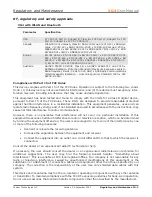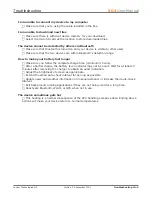
Compliance with Part 15 of FCC Rules
This device complies with Part 15 of the FCC Rules. Operation is subject to the following two condi-
tions: (1) this device may not cause harmful interference, and (2) this device must accept any inter-
ference received, including interference that may cause undesired operation.
This equipment has been tested and found to comply with the limits for a Class B digital device,
pursuant to Part 15 of the FCC Rules. These limits are designed to provide reasonable protection
against harmful interference in a residential installation. This equipment generates, uses and can
radiate radio frequency energy and, if not installed and used in accordance with the instructions, may
cause harmful interference to radio communications.
However, there is no guarantee that interference will not occur in a particular installation. If this
equipment does cause harmful interference to radio or television reception, which can be determined
by turning the equipment off and on, the user is encouraged to try to correct the interference by one
or more of the following measures:
• Reorient or relocate the receiving antenna.
• Increase the separation between the equipment and receiver.
• Connect the equipment into an outlet on a circuit different from that to which the receiver is
connected.
Consult the dealer or an experienced radio/TV technician for help.
If necessary, the user should consult the dealer or an experienced radio/television technician for
additional suggestions. The user may find the following booklet helpful: “Something about
Interference.” This is available at FCC local regional offices. Our company is not responsible for any
radio or television interference caused by unauthorized modifications of this equipment or the
substitution or attachment of connective cables and equipment other than those specified by our
company. The correction is the responsibility of the user. Use only shielded data cables with this
system.
This device and its antenna must not be co-located or operating in conjunction with any other antenna
or transmitter. To maintain compliance with the FCC RF exposure guidelines for body-worn operation,
do not use accessories that contain metallic components other than specified by the manufacturer.
Regulatory and Maintenance
XG4
User Manual
Janam Technologies LLC Version 2, September 2021
Regulatory and Maintenance 13—2
RF, regulatory and safety approvals
XG4 with WLAN and Bluetooth
Parameter
Specification
USA
47 CFR FCC Part 15, Subpart B, Class B • FCC Part 15, Subpart C • FCC
Part 15, Subpart E • FCC 47 CFR Part 2
Canada
ICES-003:2012 Issue5, Class B; RSS-210 Issue 8 (2010-12) • RSS-Gen
Issue 3 (2010-12) • ANSI C63.10-2009 • IC RSS-102 Issue 4:2010 •
IEEE1528:2013 • IEC 62209-2:2010 • KDB 248227 D01 v01r02 • KDB
447498 D01 v05r02 • KDB941225 D07v01r01
Europe
EN 301 489-1 • EN 301 489-3 • EN 301 489-17 • EN 300 328; EN 301
893 • EN 300 440 • EN 302 291-1 • EN 302 291-2 • EN 50566 • EN
62209- 2 • EN 62479 • EN 50332 • EN55022 • EN55024 • EN 61000-3-
2; EN 61000- 3-3 • IEC 60950-1/A1:2009
Australia
AS/NZS CISPR 22:2008, Class B • AS/NZS 4268:2012 +A1:2013 •
ARPANSA Radiation Protection Standard (Maximum Exposure Levels to
Radiofrequency Fields -3 KHz to 300 GHz) • ACA Radio communications
(Electromagnetic Radiation – Human Exposure) Standard 2003 • IEC
62209-2:2010



























